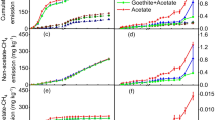Summary
In six paddy soils from the same volcanic-ash parent material, incubated under submergence, the reduction of ferric iron proceeded linearly against time. A significant negative correlation (r=−0.906, p<0.05) was found between the rate of consumption of ferric iron (reduction) and the ratio of the rate of consumption of organic N compounds to that of ferric iron. Organic N compounds are the main substrate for the iron-reduction metabolism in the soils in which the rate of iron reduction is slow. re]19751028
Similar content being viewed by others
References
Asami T. and Takai Y., Behaviour of free iron oxide in paddy soils (Part 4). Relationship between reduction of free iron oxide and formation of gases in paddy soils (in Japanese). J. Sci. Soil Manure, Japan 41, 48–55 (1970).
Kagawa H., The differences of the reduction process observed in submerged volcanic ash soils varying in the organic matter content (in Japanese). J. Sci. Soil Manure, Japan 42, 429–434 (1971).
Kamura T., Takai Y., and Ishikawa K., Microbial reduction mechanism of ferric iron in paddy soils (Part 1). Soil Sci. Plant Nutr. Tokyo 9, 171–175 (1963).
Kumada K. and Asami T., A new method for determining ferrous iron in paddy soils. Soil Plant Food Tokyo 3, 187–193 (1958).
Masui J., Shoji S. and Uchiyama N., Clay mineral properties of volcanic ash soils in the northeastern part of Japan. Tohoku J. Agric. Res. 17, 17–36 (1966).
Ottow J. C. G., Der Einfluß von Nitrat, Chlorat, Sulfat, Eisenoxidform und Wachstumsbedingungen auf das Ausmaß der bacteriellen Eisenreduktion. Z. Pflanzenernaehr. Dueng. Bodenkd. 124, 238–253 (1969).
Takai Y. and Ito K., Comparison of K2CO3 solution with MgO suspension as alkaline agent for diffusion analysis of ammonia in paddy soil (in Japanese). J. Sci. Soil Manure, Japan 34, 209–214 (1963).
Takai Y. and Kamura T., The mechanism of reduction in waterlogged paddy soil. Folia Microbiol. 11, 304–313 (1966).
Takijima Y., Studies on organic acids in paddy fields with reference to their inhibitory effects on the growth of rice plants. Part 1. Growth inhibiting action of organic acids and absorption and decomposition of them by soils. Soil Sci. Plant Nutr. Tokyo 10, 204–211 (1964).
Author information
Authors and Affiliations
Rights and permissions
About this article
Cite this article
Kagawa, H. The significance of organic N compounds as the substrate for the iron-reduction metabolism in the submerged paddy soils. Plant Soil 47, 81–88 (1977). https://doi.org/10.1007/BF00010370
Received:
Issue Date:
DOI: https://doi.org/10.1007/BF00010370




